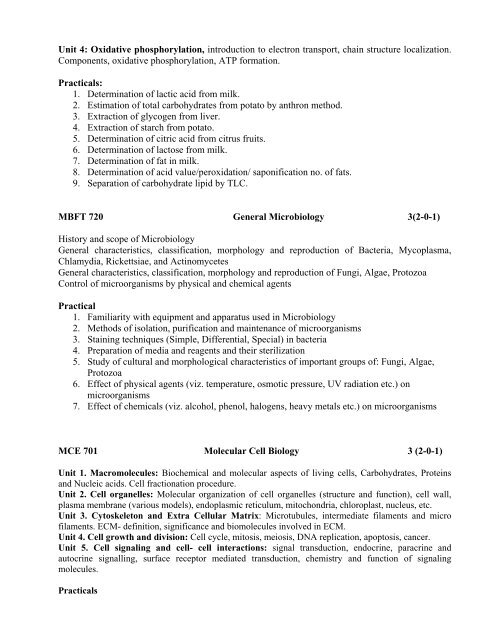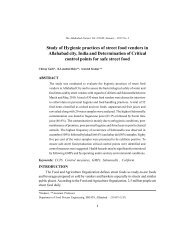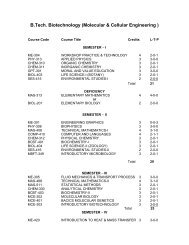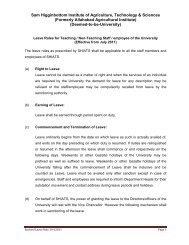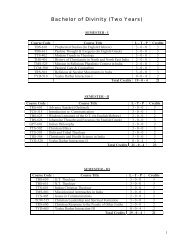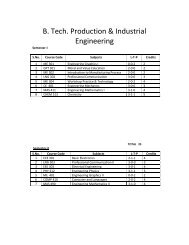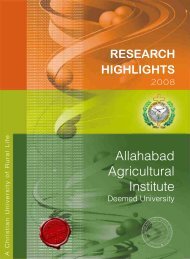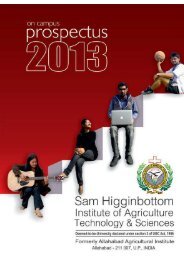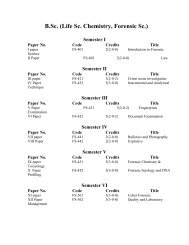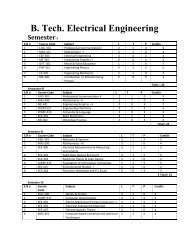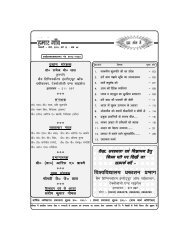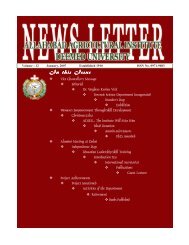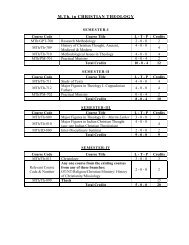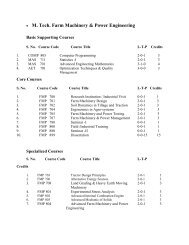M. Sc. BIOCHEMISTRY - Shiats.edu.in
M. Sc. BIOCHEMISTRY - Shiats.edu.in
M. Sc. BIOCHEMISTRY - Shiats.edu.in
You also want an ePaper? Increase the reach of your titles
YUMPU automatically turns print PDFs into web optimized ePapers that Google loves.
Unit 4: Oxidative phosphorylation, <strong>in</strong>troduction to electron transport, cha<strong>in</strong> structure localization.Components, oxidative phosphorylation, ATP formation.Practicals:1. Determ<strong>in</strong>ation of lactic acid from milk.2. Estimation of total carbohydrates from potato by anthron method.3. Extraction of glycogen from liver.4. Extraction of starch from potato.5. Determ<strong>in</strong>ation of citric acid from citrus fruits.6. Determ<strong>in</strong>ation of lactose from milk.7. Determ<strong>in</strong>ation of fat <strong>in</strong> milk.8. Determ<strong>in</strong>ation of acid value/peroxidation/ saponification no. of fats.9. Separation of carbohydrate lipid by TLC.MBFT 720 General Microbiology 3(2-0-1)History and scope of MicrobiologyGeneral characteristics, classification, morphology and reproduction of Bacteria, Mycoplasma,Chlamydia, Rickettsiae, and Act<strong>in</strong>omycetesGeneral characteristics, classification, morphology and reproduction of Fungi, Algae, ProtozoaControl of microorganisms by physical and chemical agentsPractical1. Familiarity with equipment and apparatus used <strong>in</strong> Microbiology2. Methods of isolation, purification and ma<strong>in</strong>tenance of microorganisms3. Sta<strong>in</strong><strong>in</strong>g techniques (Simple, Differential, Special) <strong>in</strong> bacteria4. Preparation of media and reagents and their sterilization5. Study of cultural and morphological characteristics of important groups of: Fungi, Algae,Protozoa6. Effect of physical agents (viz. temperature, osmotic pressure, UV radiation etc.) onmicroorganisms7. Effect of chemicals (viz. alcohol, phenol, halogens, heavy metals etc.) on microorganismsMCE 701 Molecular Cell Biology 3 (2-0-1)Unit 1. Macromolecules: Biochemical and molecular aspects of liv<strong>in</strong>g cells, Carbohydrates, Prote<strong>in</strong>sand Nucleic acids. Cell fractionation proc<strong>edu</strong>re.Unit 2. Cell organelles: Molecular organization of cell organelles (structure and function), cell wall,plasma membrane (various models), endoplasmic reticulum, mitochondria, chloroplast, nucleus, etc.Unit 3. Cytoskeleton and Extra Cellular Matrix: Microtubules, <strong>in</strong>termediate filaments and microfilaments. ECM- def<strong>in</strong>ition, significance and biomolecules <strong>in</strong>volved <strong>in</strong> ECM.Unit 4. Cell growth and division: Cell cycle, mitosis, meiosis, DNA replication, apoptosis, cancer.Unit 5. Cell signal<strong>in</strong>g and cell- cell <strong>in</strong>teractions: signal transduction, endocr<strong>in</strong>e, paracr<strong>in</strong>e andautocr<strong>in</strong>e signall<strong>in</strong>g, surface receptor mediated transduction, chemistry and function of signal<strong>in</strong>gmolecules.Practicals


